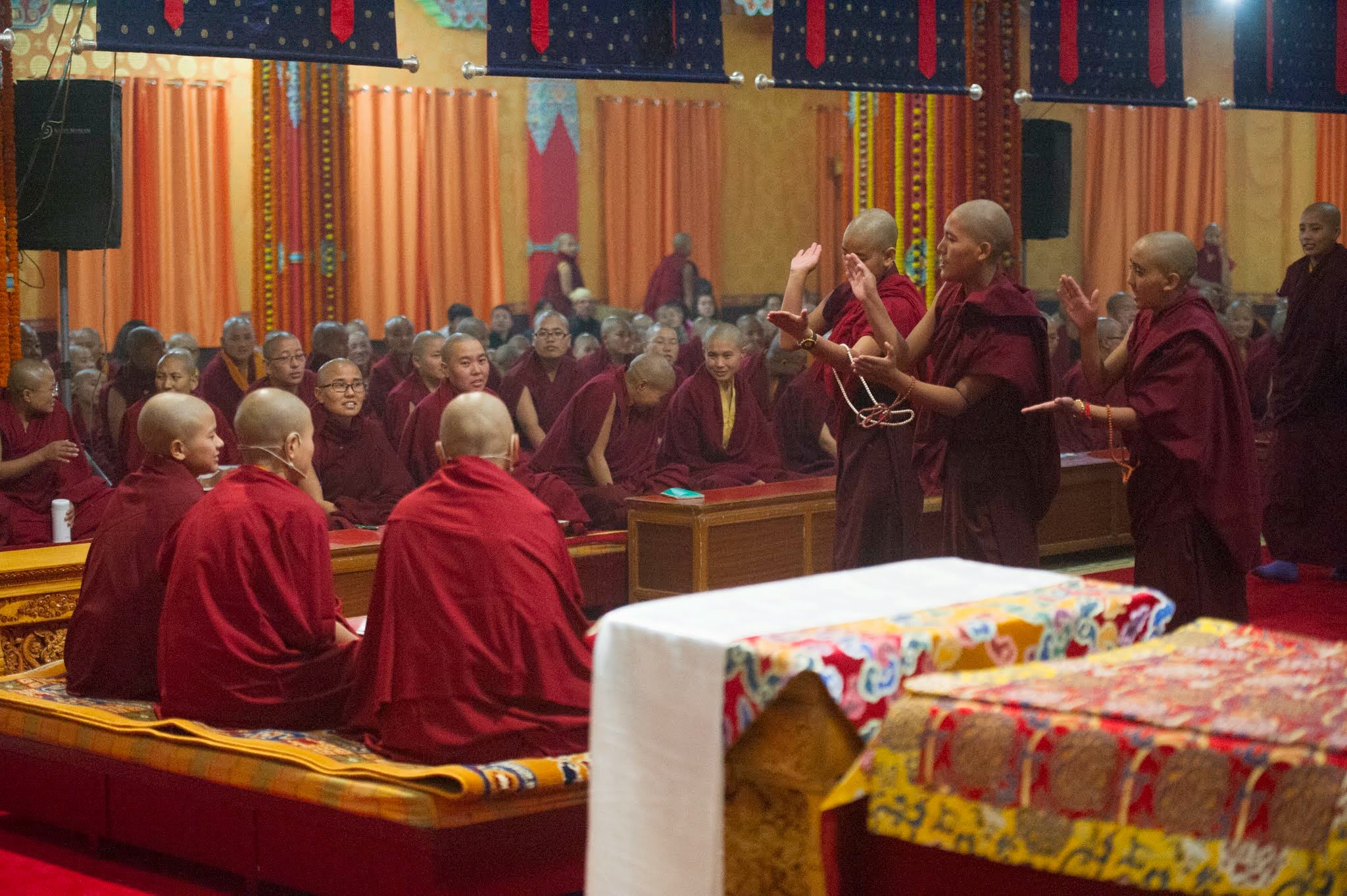This week the historical Second Arya Kshema Winter Dharma Gathering for nuns began at Tergar Monastery in Bodhgaya. The annual gathering brings together Karma Kagyu nuns in a program focused on advanced training in philosophy and debate.
“When we initiated this Winter Dharma Gathering for nuns the primary aim was to strengthen the education within Kagyu nunneries,” the Gyalwang Karmapa said. “Another aim was that the nuns would be able to take responsibility not just for activities within their own nunneries, but also take wider responsibility for upholding the teachings.”
“Monks and nuns are the same in being able to uphold the Buddha’s teachings, and have the same responsibility to do so,” he continued. “However there has been a period when nuns have not really had the opportunity to uphold the teachings, and this has been a loss for all of us.”
This year around 400 nuns from 9 different nunneries in India, Nepal, and Bhutan have gathered. The two-and-a-half week program includes intensive philosophical study and dialectical debate, complemented by daily teachings from the Gyalwang Karmapa.
At around 8.30am on January 8, the Gyalwang Karmapa was escorted into the Tergar shrine room for the opening session by two nuns skillfully playing gyalings, while a third nun led the way with sweet incense.
The shrine was arranged into rows of raised platforms for the nuns, who sat with quiet dignity, backs straight, resplendent in their yellow outer robes. His Eminence Jamgon Kongtrul Rinpoche sat on a throne to the Gyalwang Karmapa’s left, at the head of the first row of nuns, while several other tulkus, khenpos, and monks were also present. Several hundred lay people filled all the remaining space in the room, eager to take part. Garlands of golden flowers adorned the doorways and pillars, adding a celebratory atmosphere to the gathering.
The opening session began with the pure and confident sound of the female umzes’ voices ringing throughout the gompa, leading the entire gathering through the refuge, bodhicitta, and Kagyu lineage prayers. In a clear demonstration of their devotion and support for the nuns, a large group of sponsors then made mandala offerings to the Gyalwang Karmapa and all the nuns.
As was the case during the first Arya Kshema Winter Dharma Gathering, the Gyalwang Karmapa wasted no time before raising the issue of bhikshuni ordination. He explained to the nuns that some precedent for granting full ordination or Bhikshuni vows existed, from the time of the Eighth Karmapa.
“The Eighth Karmapa, Mikyo Dorje, wrote a collection of vinaya rituals. In this he wrote: if you need to give the Bhikshuni vows then you should change the Bhikshu ritual to be able to do it. Therefore, the male Bhikshu sangha on its own is able to give the Bhikshuni vows.
“Among all the collections of vinaya rituals in Tibetan, it’s probably only Mikyo Dorje who has altered the Bhikshu vow ritual for the Bhikshunis. He was known to give the Bhikshuni vow with only the Bhikshu sangha giving the vow. When we look at the activity of this previous Karmapa, he also put a lot of effort into supporting and reviving the nuns’ communities in general.
“I think it’s important for me to do everything I can in order to support nuns’ teachings and practice, and to increase their listening, contemplation, and meditation. So I want to put as much effort into this as I can, from the bottom of my heart. I think this is something that’s appropriate for me to do from now until the end of this lifetime. I think it’s something that fits well with the activities of the previous Karmapas, and it’s also something that is definitely necessary within our contemporary society.”
The Gyalwang Karmapa then continued his teaching on Gampopa’s Jewel Ornament of Liberation, begun last year, picking up from chapter 6 in the text on the topic of karma cause and effect. “This is the most important text to unify the instructions of the Kadampa and Mahamudra lineages, and for that reason it’s something all Kagyupas should study,” he told the nuns. He highlighted how important and wonderful it was that the nuns now had the opportunity to study the five great texts traditionally studied in the shedras.
While last year’s inaugural Arya Kshema Winter Dharma Gathering focused on the Gyalwang Karmapa’s teachings, this year the nuns have now spent the past year studying basic logic and elementary to intermediate topics of philosophy, so during the Winter Dharma Gathering there will be greater emphasis on actual training in debate. The Gyalwang Karmapa teaches the nuns from 8.30–11am most mornings, while each evening the nuns practice their dialectical debating skills on different selections from the ‘Collected Topics’ or ‘Dudra’. Several special pujas and practices are also scheduled, including a Tara puja, Chöd: A String of Jewels, and a special ritual for the nun’s dharma to flourish, composed by the Gyalwang Karmapa himself.
The Gyalwang Karmapa’s teachings during the Arya Kshema Winter Dharma Gathering are also being webcast live around the world, with translation into English, Chinese, Spanish, Polish, Korean, and German. Around 1000 people from 60 different countries tuned in for the opening session.


















